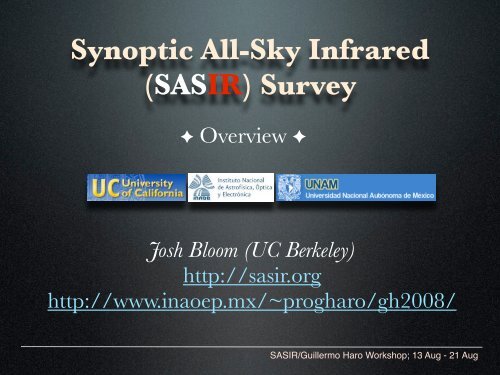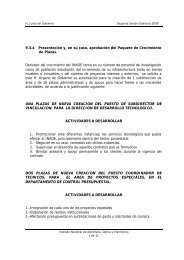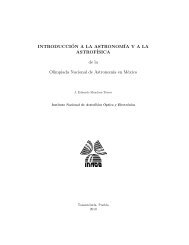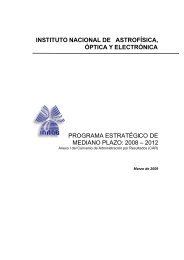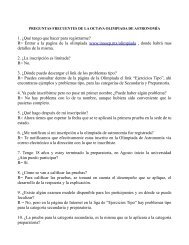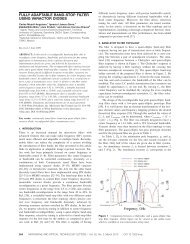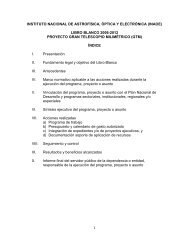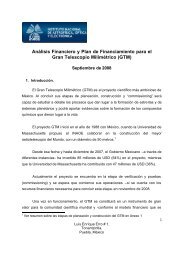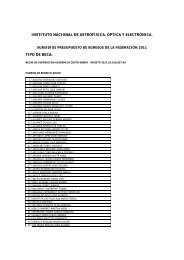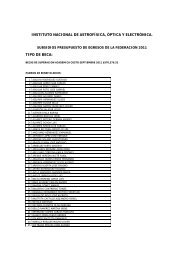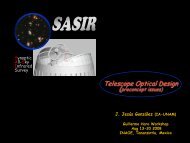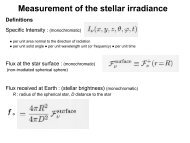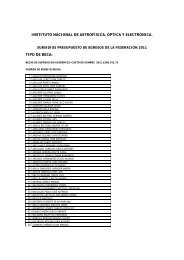You also want an ePaper? Increase the reach of your titles
YUMPU automatically turns print PDFs into web optimized ePapers that Google loves.
Synoptic All-Sky Infrared<br />
(<strong>SASIR</strong>) Survey<br />
✦ Overview ✦<br />
Josh Bloom (UC Berkeley)<br />
http://sasir.org<br />
http://www.<strong>inaoe</strong>p.mx/~progharo/gh2008/<br />
<strong>SASIR</strong>/Guillermo Haro Workshop; 13 Aug - 21 Aug
Outline<br />
‣Overview of the Survey & the Science<br />
‣Series of Questions & Goals for this Workshop<br />
‣Timeline for Action & Decisions
<strong>SASIR</strong> vision: In a Nutshell<br />
6.5 meter telescope<br />
• site: San Pedro Mártir<br />
• ~0.8° diameter field of view<br />
• Filters: Y J H K (3 dichroics)<br />
• cover entire sky in ~3 months;<br />
4 year survey<br />
• “shallow” (~2.5 π; 12 visits per<br />
filter), “medium” (0.5 π; 200<br />
visits) & “deep” (~1000 sq deg;<br />
10 3 + visits) surveys<br />
(Magellan-inspired)<br />
New Phase Space:<br />
Aperture + wavelength +<br />
Field of View + Time
Backdrop: Modern OIR Large-Area Surveys<br />
2MASS [1997 - 2000]<br />
4 π, simultaneous JHKs on 1.3m telescopes, 2500+ papers<br />
Sloan Digital Sky Survey (SDSS I & II) [2000 - 2008]<br />
~1.5 π (North), ugriz on 2.5m, 250 sq. deg synoptic<br />
Pan-STARRS [2008 - 2011]<br />
~2.5 π (North), ugrizy on 1.8m, 20000 sq. deg synoptic<br />
LSST [2013 - 2020?]<br />
~2.5 π (South), ugrizy on 8.5m, 30000 sq. deg synoptic<br />
JDEM/SNAP [2013 - 2018?]<br />
~4 π (space), ugrizyJH on 2m?, 5000 sq. deg synoptic
Multi-threaded Science Goals<br />
Static Sky<br />
‣ uncover the entire brown dwarf & Y dwarf population with 25 pc<br />
‣ IMF studies (A. Porras)<br />
‣ dwarf/dark matter problem & Galactic structure (O. Valenzuela)<br />
‣ galaxy evolution studies (V. Ávila-Reese)<br />
‣ galaxy clusters z > 1 (A. Stanford)<br />
‣ lensing (w/ GTC & LMT) (J. A. de Diego)<br />
‣ obscured quasars (B. Becker)<br />
‣ high-redshift quasars z > 7 (J. X. Prochaska)
Multi-threaded Science Goals<br />
Transients<br />
‣ fast transients (orphan GRB afterglows?)<br />
‣ local distance scale (< 4 Mpc) with Mira Variables (L. Georgiev)<br />
‣ exoplanet transit survey<br />
‣ cosmology/distance ladder: supernovae, RR Lyrae, etc.<br />
‣ E&M connection to GWs (advanced LIGO) & cosmic particles<br />
‣ high redshift transients (e.g. GRBs)<br />
‣ connection to high-energy universe (T. Miyaji, A. Carramiñana)<br />
Critical Connection to Other Projects<br />
‣ LMT (D. Hughes)<br />
‣ adaptive optics grid (J. Girard)<br />
‣ great photo-z improvement over LSST (e.g. BAO)<br />
‣ support for GTC & Keck/TMT
Identifying the Killer Science:<br />
Discovering the High-redshift Universe
2 Nominal Optical Designs<br />
details from Jesus Gonzales
The Camera<br />
• 3 dichroics - size may be one<br />
of the most significant<br />
constraints (~0.5 m)<br />
• cold optics<br />
• 80 - 100 2k x 2k H2RG or<br />
VIRGO arrays (15 - 20<br />
micron = 0.2 - 0.3”/pix)<br />
• data rates: ~1.5 Gb per<br />
double correlated read<br />
~2 Tb/night<br />
~300 Mbps<br />
• $30 - 40M<br />
(data flow: Peter Nugent<br />
detectors: Josh<br />
camera optics: Jesus)
Bandpasses (for now)<br />
overall<br />
QE<br />
atmospheric<br />
transmisson<br />
Y J H Ks<br />
wavelength [micron]<br />
from simple simulation code
Quick <strong>SASIR</strong> Simulation
Comparison to Other Surveys<br />
Filter<br />
5 sigma<br />
limiting mag<br />
[AB]<br />
2MASS<br />
flux density<br />
μJy<br />
J 18.13 202<br />
H 17.63 320<br />
Ks 17.55 346<br />
5 sigma limiting mag<br />
[AB]<br />
flux density<br />
μJy<br />
22.54 3.5<br />
22.04 5.5<br />
21.95 6.0<br />
<strong>SASIR</strong>/single epoch<br />
5 sigma limiting mag<br />
[AB]<br />
flux density<br />
μJy<br />
23.89 1.0<br />
23.39 1.6<br />
23.30 1.7<br />
<strong>SASIR</strong>/shallow<br />
Limiting flux ratio ∝ √ 1/t × (FWHM) ×1/r<br />
NOTE for a fixed S/N:<br />
Limiting mag difference = 1.25 log t +2.5 log FWHM + 2.5 log r
Comparison to Other Surveys<br />
Filter<br />
5 sigma<br />
limiting mag<br />
[AB]<br />
2MASS<br />
flux density<br />
μJy<br />
J 18.13 202<br />
H 17.63 320<br />
Ks 17.55 346<br />
5 sigma limiting mag<br />
[AB]<br />
flux density<br />
μJy<br />
22.54 3.5<br />
22.04 5.5<br />
21.95 6.0<br />
<strong>SASIR</strong>/single epoch<br />
5 sigma limiting mag<br />
[AB]<br />
flux density<br />
μJy<br />
23.89 1.0<br />
23.39 1.6<br />
23.30 1.7<br />
<strong>SASIR</strong>/shallow<br />
Extended<br />
Source<br />
Sensitivity<br />
(“shallow”)<br />
Filter<br />
Y<br />
J<br />
H<br />
Ks<br />
5 sigma limiting mag<br />
[AB arcsec -2 ]<br />
flux density<br />
μJy arcsec -2<br />
23.32 1.7<br />
22.78 2.8<br />
22.42 3.8<br />
22.29 4.4
Comparison to Other Surveys<br />
K-band Imaging<br />
2MASS<br />
<strong>SASIR</strong><br />
2MASS [Skrutskie et al. 2006]<br />
VLT/ISSAC (GOODS) [Retzlaff et al. 2008]
Comparison to Other Surveys
Questions & Goals<br />
{<br />
see William/Xavier’s email<br />
with formal questions }
Science<br />
‣What are main science results you want from<br />
<strong>SASIR</strong>? (Where would we excel over existing &<br />
planned surveys?)<br />
‣What are the specific technical requirements of<br />
the survey to achieve this science?<br />
Examples:<br />
✦ local cool stars parallax demands at least 3<br />
visits, with 2 visits separated by ~6 months<br />
✦ we must have K-band because...<br />
‣What are the synergies with planned missions<br />
(JDEM, LSST, JWST, etc.)?
Technical<br />
‣What are the ranges of reasonable parameters for<br />
the mirror, telescope & camera?<br />
‣ What are the innovations & long-lead time items<br />
we need to worry about now?<br />
‣ What are the main “show stoppers” for each subsystem?
Collaboration<br />
‣ Continue to build & grow the science & technical<br />
partnerships<br />
‣ Develop a roadmap for engaging our colleagues<br />
‣ Start discussing details of collaboration<br />
agreement<br />
‣ Start discussing extensions to partnership (i.e.<br />
other institutional partners, facility-leveraging)
Timeline for Action<br />
[Bolte, Guichard, Franco]
Funding Outlook for Design Phase<br />
(more from Pepe & Mike)<br />
What Due For What<br />
Funding<br />
Profile<br />
UC-Lab Research<br />
Program<br />
4 Aug 08<br />
[pending]<br />
project management, optical<br />
designer, LSST-like simulation,<br />
collaboration meetings in Mexico<br />
$1.5M over 3 years<br />
(2009-2011)<br />
NSF/Advanced<br />
Technologies and<br />
Instrumentation<br />
1 Nov 08 TBD<br />
$


